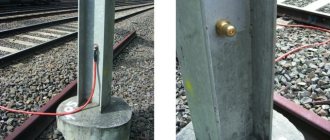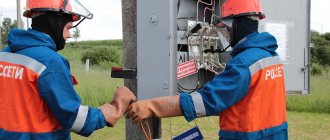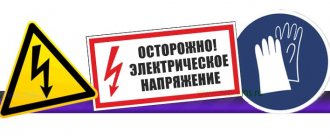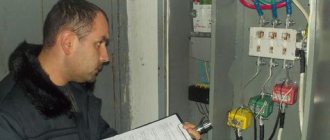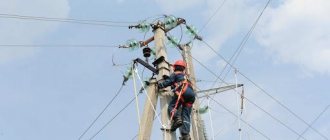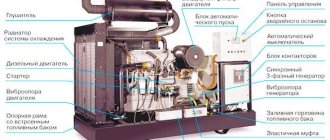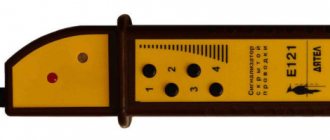The main regulatory document regulating the reliable, coordinated operation of energy facilities that gives the highest economic effect is the PTE of power plants and networks. They spell out all the nuances that apply to organizational and technical tasks that arise during the construction, launch and operation of energy structures.
PTEEESS RF
Operation of power plants and networks
In the rules for the technical operation of power plants and networks (PTEESS), one of the provisions addresses issues such as:
- launch and acceptance of newly built installations and structures;
- basic requests for service personnel;
- creating control over the efficiency of processes;
- technical control over the operation of electrical installations and power plants;
- repair, maintenance work and equipment modernization;
- maintaining technical documentation;
- ACS devices (automatic control systems).
The set of rules also includes a unified regulation for making measurements throughout the Russian energy system.
Power system of Russia, diagram
Rules for acceptance of structures and equipment into operation
Attention! The rules of this section considered in the Ptess include tasks imposed on newly built or technically refurbished structures and equipment.
Before talking about acceptance, you need to know what the start-up complex (power facility) is.
Launch complex
Important! During the process of construction or re-equipment, intermediate tests of both components and hidden work must be carried out.
Verification of compliance with the 2003 PTE before operational tests is mandatory.
All detected deficiencies, installation or construction defects identified during the inspection must be eliminated before the start of comprehensive testing.
Comprehensive testing
For your information. Normal uninterrupted operation of the main equipment for 72 hours with a load equal to the rated load is considered a comprehensive test. For power lines (PTL), the time interval is 24 hours.
Rules requirements for personnel
When staffing teams of repair, maintenance and operational dispatch personnel, a number of requirements are met.
Personnel requirements
Necessarily. In case of violations of these Rules, each employee is obliged to inform his immediate supervisor and try to eliminate the violations independently. Studying and following safety rules is the responsibility of the employee.
Ways to control the efficiency of energy facilities
In order to control the productivity of power plants (thermal or hydropower plants), developed energy parameters are used. The graphs, tables and annexes show the dependence of thermal and electrical loads on the economic and technical performance indicators of the equipment. To these can be added graphs of the consumption rates of raw materials (water or fuel) required to generate the supplied energy.
Information. The need to develop such characteristics for zoned boiler houses and low-power power plants is established by the regional JSC Energo.
Technical supervision of the operation of energy facilities
Technical supervision for inspections, technical examinations and surveys is established by relevant orders for the enterprise.
Technical Supervision
Important! The commission must assess the condition and outline measures to maintain and ensure the approved resource of the installation.
Modernization, repair and maintenance (TO)
Due to the wear and tear of buildings, structures and electrical equipment during operation, the problem of repair and replacement of worn-out components arises. Due to the specific nature of energy production, unplanned or emergency downtime (with complete or partial loss of power) entails great damage to consumers.
Attention! Unexpected shutdown of failed equipment leads to its damage. In addition, an emergency situation can threaten the life and health of personnel servicing the system.
To prevent this from happening, the following must be planned:
- modernization – replacement of obsolete equipment with new, more modern equipment;
- scheduled repairs: major (has the goal of restoring the full working life of the installation with the replacement of basic components) and current (maintaining the operation of the installation within the specified parameters with the replacement of wearing parts);
- maintenance – work not related to repairs (walk-throughs, inspections, lubrication, identification of deviations from the norm, replacement of consumables).
A separate section in the Rules deals with the reconstruction of facilities, which entails:
- increase in power;
- reduction of labor costs;
- reduction in material consumption.
Reconstruction leads to improved production performance and reduced energy costs.
An example of a power plant's maintenance schedule
Technical documentation of the power facility
Every enterprise in the energy industry must have a set of documentation.
List of documentation
In addition, there must be fire extinguishing and evacuation plans approved by fire authorities.
Automated control systems (ACS)
Allows you to control the operation of systems in automatic mode. A properly organized and implemented system makes it possible to optimize the number of staff and exercise control over the quality and operation of the facility.
Important! The implemented automated control system must be adaptively flexible to subsequent upgrades and various changes in application conditions.
Automated power facility control center
Unity of measurements
All measurements carried out in the energy sector must comply with the accuracy indicators accepted in Russia and be expressed in units used in the Russian Federation. This is necessary to ensure that all obtained results are comparable, regardless of time, place and measurement methods used.
Technical documentation
Safety rules for operating electrical installations
To correctly implement the PTE rule at any enterprise, regardless of the specifics of the activity, it is necessary to know the characteristics of objects that are under constant voltage. Objects such as a power plant, reservoir, power plant, electrical installation, special-purpose electrical equipment depend on both the rate of energy production and, accordingly, the presence of dangerous voltage, as well as the measures being developed to neutralize the negative consequences.
When drawing up a special action plan, technical documentation is also developed, which, in addition to a detailed description of the operating principle and design of energized systems, includes possible technical malfunctions and ways to solve them, as well as measures in the event of an abnormal or emergency situation.
Typical High Voltage Electrical Installation
Territory of power plants, requirements
Differential automatic machine reliable protection of electrical circuits and people
When arranging the territory, pay attention to the following points:
- implementation of surface water drainage;
- installation of noise-absorbing devices;
- organization of engineering structures: gas pipelines, sewerage, heating mains, water pipelines, etc.;
- execution of transport infrastructure: roads, approaches to fire reservoirs, pedestrian paths, bridges, etc.;
- installation of wells to control groundwater levels;
- security of the territory and arrangement of checkpoints (checkpoints).
Landscaping and landscaping are also included in a number of requirements.
Modernization, repair and maintenance
In the course of its activity, any industrial equipment eventually requires a repair or modernization procedure. To implement this, the company must also have technical documentation of these facilities and a list of preventive measures. Such measures indicate protective equipment, the use of additional tools, a reference to compliance with PTESS rules, the hazard status of such an object and other characteristics that may create a danger when performing certain work.
Hydraulic structures of power plants
Methods of fire protection of electrical communications
PTE RF sets requirements for the reliability and safe operation of hydraulic structures. This is facilitated by drainage and anti-filtration devices and mechanisms. The rules emphasize service:
- dams and dams;
- drainage systems;
- berms and ditches.
Their long-term operation is ensured by the following conditions:
- protection from external influences;
- periodic condition monitoring.
All nuances related to the safe condition are transmitted in writing to supervisory structures.
Equipment of hydraulic structures
The valve equipment mechanisms are maintained in working order. During inspections (every 60 months), attention is paid to the following points:
- presence of a maximum opening height marker;
- absence of mechanical obstacles during operation;
- absence of vibrations, mechanical deformations, precise shrinkage on the threshold.
Ropes, alarms, grounding and wires are checked once every 12 months.
Dam gate
Water regime for power plants
Once every 10 years, the rules for the water regime of hydroelectric power plants are reviewed. There are two types of modes: working and special. The operating mode allows the use of water resources to ensure optimal plant load.
A special regime - before the spring flood, it includes:
- maximum (by level) filling;
- dumping excess water volume, with the ability to let ice and sediment through;
- the ability to maintain the normal functioning of irrigation and shipping.
In a special mode, additional control of water discharge occurs in order to ensure the safe operation of hydraulic structures.
Water discharge
Hydraulic structures in winter
Before the winter cold, they check the operation of the slush collectors and clean the sedimentation tanks for it. If hydraulic structures are not designed for ice pressure, then a hole is created in front of them. All winter it is cleared of ice.
For your information. Winter measurements of water temperature are carried out daily to determine when to turn on the heating for the grates. When the ice has not yet frozen, sludge can be passed through turbines or sludge dumps.
Power plant reservoir requirements
The rules describe in detail all the requirements for the location of water storage for hydroelectric power plants. The main activities include:
- allocation of a protective zone in which water use is limited;
- cleaning the reservoir from silt and thickets;
- protection of the coastline and its constant monitoring;
- laboratory sampling of water to analyze its quality;
- control of water temperature and ice condition in winter.
The rules oblige the implementation of environmental protection measures within the boundaries of the protection zone.
Reservoir protection zone
Hydro turbine units
These Rules regulate the uninterrupted operation of hydraulic turbines at rated load. At the same time, the efficiency (efficiency factor) is above average. If necessary, the installation must immediately switch to maximum load mode. This is ensured by a number of conditions:
- absolute automation of all hydroelectric power station units;
- possibility of stable operation with 100% open shutters;
- The synchronous compensatory mode of the hydraulic unit, if necessary, must immediately switch to the generator mode.
Attention! With three or more hydraulic units, GRAM (group active power control) is installed.
Technical water supply for power plants
Cooling towers are used to cool and distribute the water used. The walls of the devices have an anti-corrosion coating, which is cleaned once every two years to remove deposits. The waterproofing of the sheets is restored as necessary.
Water treatment measures
Commissioning of energy facilities
When carrying out a construction, repair or maintenance procedure, the final point is the commissioning of such a facility. This procedure involves several stages in addition to the construction itself and requires mandatory documentation of each of them.
Commissioning works
Rules for labor protection during the operation of industrial transport
When constructing a new facility, commissioning work is mandatory, which is associated with an increased danger of such installations, since the launch of work processes occurs for the first time.
Note! During the execution of this promotion, it is necessary to adhere to the entire range of security measures.
Test procedure
Testing of installations is carried out only if there is control and supervision by company officials with a certain electrical safety category, who are directly responsible for the work performed. Moreover, such work is carried out with the mandatory use of all primary protective equipment and special equipment.
Carrying out preventive measures at the station in compliance with operating rules
Acceptance (final stage)
The final stage of commissioning a new station is its acceptance. Such a procedure is formalized by a special act, in which the parties indicate the circumstances of construction or repair, identified defects and can reflect a special opinion if there are disagreements. After signing, all technical information about the facility and the features of its operation are transferred with a description of hazardous production factors and safety equipment used during its maintenance.
Fuel and transport facilities of power plants
Installation of overhead electrical sockets
Network railway transport, supplying fuel by rail directly to the territory of the hydroelectric power station, must operate without interruption. The unloading process is completely mechanized. Pteesis RF is prescribed:
- control over the quality of raw materials;
- timely delivery to the station;
- keeping the areas adjacent to unloading clean.
Control equipment (scales, measuring instruments) must be calibrated and tested.
Fuel for power facility
Based on the type of fuel supplied to the power plant for operation, it is divided into the following types:
- hard;
- liquid;
- gaseous.
During the cold period, solid fuel is defrosted and loosened at unloading sites. According to the rules, this is carried out according to the regime map. Periodic sampling and checking the serviceability of mechanisms are regulated.
Liquid fuel is drained through a closed fuel line, filtered and supplied continuously. It is recommended to pay attention to the following questions:
- serviceability of devices;
- permissible fuel temperature range;
- viscosity;
- pressure;
- availability of a passport for the pipeline.
Fuel for storage must be taken from the upper layers of the tank contents. The frequency of monitoring the quality of stored stock can be developed locally.
Gaseous fuel is supplied to the burners of the units through a gas pipeline. All features of the organization and maintenance of the gas industry are regulated in detail in the Rules.
Thermal power plants, types of fuel
Document status and scope of application
The regulatory document we are interested in came into force on June 30, 2003. To ensure compliance with the requirements contained in it, its text has been amended several times. In total, during the period of its validity, 5 orders of the Ministry of Energy were adopted, which contained adjustments to the existing provisions. Moreover, the bulk of such documents were developed in 2022 - during this year the ministry published four orders containing updated positions. Another order was adopted in 2018.
The provisions of Order No. 229 apply to the organization of work at the following types of facilities:
- thermal power plants that use organic fuel;
- hydroelectric power stations;
- Electricity of the net;
- heating network;
- organizations performing the necessary types of work on the listed categories of objects.
Power plants and networks, electrical equipment
Section PTE SO 153-34.20.501-2003 discusses:
- generators and synchronous compensators;
- electric motors;
- power transformers;
- reactors;
- voltage distribution devices.
The requirements for the technical operation of each item are considered from the point of view of safe, reliable and long-term operation.
Electrical requirements
Training and professional development
Rules for labor protection during operation of thermal power plants
An integral part of preserving and maintaining a safe level of work activity in production is the constant training of enterprise workers in the provisions and requirements of legislation in the field of labor protection. Such training is usually carried out in specialized educational institutions that have appropriate certification in this field.
However, in some cases, if the company has a certain staff of employees with the appropriate level of knowledge, such training is carried out on the job without interruption from direct work activity.
Requirements for power cable lines
Ptess, as a manual for maintenance and repair, provides the following requirements:
- maintenance of power overhead and underground cable lines: power lines, subway and railway contact networks, etc.;
- providing climate control in cable channels;
- maintenance of cable routes;
- control over current load and core heating temperature.
Carefully! For cables with a service life of more than 15 years, current overload is permissible no higher than 10%. Overcurrent for paper-insulated cables operating at a voltage of 35 kV is unacceptable.
Compliance with Rules SO 153-34.20.501-2003 regulates all types of maintenance, repair and operation of energy facilities. Deviation from norms and recommendations entails emergency situations, equipment downtime, and threatens the health and life of operating personnel.
Technical characteristics of existing stations
Operating stations have a wide variety of characteristics, ranging from rated power to dimensions. When servicing electrical installations, the main factor is the network voltage, which determines not only the list of equipment used, but also the degree of danger to humans:
- Stations up to 1000V pose less of a threat and, in the event of electric shock, most often cause non-fatal harm to health;
- Installations with voltages over 1000V require strict adherence to all precautions, since in the event of an impact they most often lead to the death of the victim.
Structural elements of a diesel power plant
A diesel engine is a device that converts the rotating element of an engine into energy using an alternating current generator. It consists of the following structural elements :
- Four-stroke internal combustion engine with one or more cylinders (up to 8 pieces, depending on the type of engine);
- Air and fuel supply system, consisting of a turbocharger and fuel pump;
- An alternator, which is a synchronous or asynchronous generator with one or three phases (for generating electricity 230 V or 400 V, respectively);
- Cooling system, consisting of a pump, radiator, pipe, fan and coolant (antifreeze or water);
- Automatic control systems, which are designed to start the generator in automatic mode (without an installation operator);
- Fuel tank (depending on the type of diesel power plant, the tank volume can vary from 200 to 300 l);
- Steel frame with damper pads, designed to protect equipment from the destructive effects of vibration;
- An external frame (container), which is necessary to absorb noise and protect against negative external factors (environment, physical damage, etc.).
Safety precautions
General rules
- Personnel must comply with established safety rules.
- The launch of diesel power plants is prohibited if there is a suspicion of danger.
- If the equipment is damaged, hazard warning signs must be posted and the battery cable must be disconnected.
- Repair work can only be carried out with the battery cable disconnected.
Installation of diesel power plant
- Observe grounding requirements during electrical installation work.
- Check that the fuel supply system complies with the established standards.
- Check the presence of protective thermal insulation on the exhaust system and muffler.
- To climb onto the body, use only special devices.
- Check the serviceability of the lifts.
- Make sure there are no people between the crane and the diesel engine when lifting.
Fire and explosion safety
- Check for fire extinguishers.
- Check the quality of ventilation.
- Clean up spills of fuel and other liquids in a timely manner.
- Do not smoke near fuel or batteries.
- Do not refuel with the engine running.
- Stop the diesel engine when there are leaks and turn it on only after they have been completely eliminated.
Mechanical influences
- It is prohibited to operate diesel power plants in the absence of a protective fence.
- Keep fingers, hair, and loose clothing away from moving parts of the equipment.
- The doors of the installation compartments must be closed when starting the diesel power plant.
- Avoid direct contact with oils and other liquids.
- You must wear protective clothing and a helmet.
Chemical influences
- Avoid direct contact with skin and contact with mucous membranes of all liquids used in DES.
- Replace protective clothing if fuel or oil comes into contact with it.
- Use a protective mask, goggles and apron.
Noise impact
- Long-term exposure to noise levels exceeding 85 dB is harmful to health.
- Use earplugs if you do not have a noise-reducing hood.
Electrical impact
- Work on diesel power plants should only be carried out by trained personnel.
- It is necessary to check the grounding at every start.
- Connecting or disconnecting the load can only be carried out with the diesel power plant turned off and the battery terminal disconnected.
- Do not touch live parts.
- Check the compliance of the electrical characteristics and power when connecting the diesel power plant to the load.
- During maintenance, you need to make sure that the equipment is de-energized.
- Check wires and insulation system for damage.
- In case of fire, fire extinguishers BC or ABC should be used.
